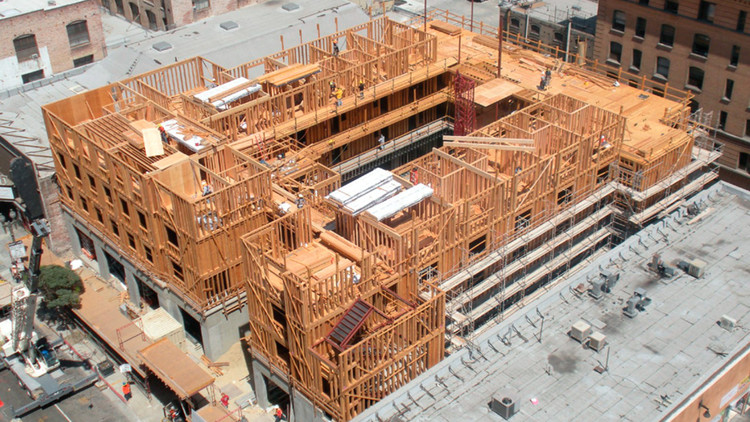
Podium construction – alternately known as platform or pedestal construction – is a building typology characterized by a horizontal division between a lower ‘podium’ and an upper tower. The podium, which is typically made of concrete or steel, is crowned by multiple light wood-frame stories. Often, the lighter upper structure contains four to five stories of residential units, while the podium houses retail, commercial, or office spaces and above- or below-grade parking. An alternative configuration sports six to seven residential stories (including the podium) and subterranean parking. Some visible examples of this podium construction style include the amenity-rich Stella residences designed by DesignArc; an attractive yet cost-effective student housing project for the University of Washington by Mahlum Architects; and the warm, modern University House Arena District also designed by Mahlum Architects in Eugene, Oregon.

Podium design has been gaining popularity in North America for a variety of reasons. Land costs continue to increase alongside steel and concrete costs, encouraging the increased use of higher density wood design. Labor costs are also lower for wood construction [1], while mitigating the use of steel and concrete decreases carbon emissions [2]. These factors, combined with construction speed [3] and design flexibility [4], indicate that podium construction is likely to continue to rise.

With these benefits, however, come a series of challenges and special considerations specific to podium construction that architects and developers should consider to maximize the value of this method. One such issue is that of the particular limitations set on podium design by the International Building Code (IBC). Most podium-style buildings are designated as either Type III or Type V under the IBC, which are then further subdivided into A and B based on the rigorousness of the fire- resistance elements. While residential Type III-A constructions may be 65 feet and four stories, Type V-A buildings may only reach 50 feet and three stories. With an NFPA 13 automatic sprinkler system, these limits increase by one story and up to 20 more feet. These restrictions may vary case-by-case, while complications such as dramatic grade changes may further complicate given height limitations. These nuances, among others, are more comprehensively explored in the Wood Product Council's educational materials and articles.

Other challenges include the material and structural considerations unique to podium design. Typically, Type V wood-framed towers utilize platform framing, a type of framing in which the joists sit on top of the double top plates of the walls. Another option, which is more popular for Type III structures, consists of balloon framing, in which the floor framing hangs off the double top plates instead of atop them. These structural differences stem from the 1-hour rated versus 2-hour rated walls specific to each building type.

In turn, the interface between these wooden superstructures and their lower podium portions is often even more complex due to issues with code interpretation, constructability, and coordination. To investigate one of them, the constructability of the common post-tension poured-in-place design is challenged by the risk of cutting a tendon while drilling into a post-tensioned concrete slab. An effective solution is to use wire cages: these are fastened to the bottom of the form and clearly indicate where anchors and tendons need to be placed separately [5]. Again, similar structural challenges and their solutions are provided in further detail by existing educational literature.

Some other notable examples of effective podium design include JHP Architects’ Cityville Cityplace, Withee Malcolm Architects' Avalon at Anaheim, and Gensler's MOTO. These projects introduce the expanding potential of this sustainable and cost-friendly construction style, while educational materials by organizations such as ThinkWood attempt to make it more accessible. Altogether, these materials and inspirations help facilitate the rise of podium design in an urban fabric where spatial efficiency and sustainability are increasingly becoming a necessity.
To learn more visit www.thinkwood.com.

Notes
[1] Prefabricated Wood Construction Shows Promise, NAIOP, Development Magazine, 2019. Retrieved from https://www.naiop.org/Magazine/2019/Spring-2019/Business-Trends/Prefabricated-Wood-Construction-Shows-Promise
[2] A comparative analysis of building materials for sustainable construction with emphasis on CO2 reduction, International Journal of Environment and Sustainable Development, Mahmud & Shams, 2011, p.372-373, https://www.researchgate.net/publication/264817319_A_comparative_analysis_of_building_materials_for_sustainable_construction_with_emphasis_on_CO2_reduction
[3] Off-Site Studies: Solid Timber Construction, University of Utah, Integrated Technology in Architecture Center, College of Architecture and Planning, 2015, https://cdn.ymaws.com/www.nibs.org/resource/resmgr/OSCC/OffSite_Studies_STC.pdf
[4] Design Criteria For Increasing Building Flexibility: Dynamics And Prospects, Sadafi, Nasibeh & Mohd Zain, Muhammad Fauzi & Jamil, MD, Environmental Engineering and Management Journal. 13. 407-417, 2014, https://www.researchgate.net/publication/287183152_Design_criteria_for_increasing_building_flexibility_D ynamics_and_prospects
[5] Wood Buildings Aim High: Benefits and Engineering Challenges of Podium Design, 2011, https://www.woodworks.org/wp-content/uploads/CS-Podium.pdf


